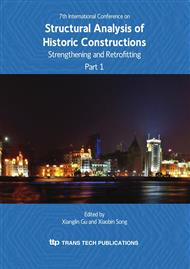[1]
Amici, C M (2005). From project to monument, " in "The Basilica of Maxentius. The Monument, its Materials, Construction, and Stability. " Giavarini, C (ed. ) (2005). Rome, Italy: "L'Erma" di Bretschneider: Università di Roma "La Sapienza,. CISTeC.
DOI: 10.1017/s0075435800002264
Google Scholar
[2]
Barosso, M (1940). Le construzioni sottostanti la Basilica Massenziana e la Velia, in Atti del V Congresso Nazionale di Studi Romani, vol. 2. Rome, Italy: Istituto di Studi Romani Editore.
DOI: 10.1163/1574-9347_bnp_e1406850
Google Scholar
[3]
Choisy, A (1873). L'art de bâtir chez les Romains. " Paris, France: Librairie générale de l'architecture et des travauz publics Ducher et Cie. Spanish translation (1999) "El arte de construir en Roma., Madrid, Spain: Instituto Juan de Herrera.
Google Scholar
[4]
Durm, J (1885). Handbuch der Architektur: Die baukunst der Etrusker; Die Baukunst der Römer., Darmstadt, Germany: Bergsträsser.
Google Scholar
[5]
Ferretti, A S (2005).
Google Scholar
[6]
Giavarini, C (2005). Materials" in "The Basilica of Maxentius. The Monument, its Materials, Construction, and Stability. " Giavarini, C (ed. ) (2005). Rome, Italy: "L'Erma" di Bretschneider: Università di Roma "La Sapienza,. CISTeC.
DOI: 10.1017/s0075435800002264
Google Scholar
[7]
Heyman, J (1995). The Stone Skeleton., Cambridge, United Kingdom: Cambridge University Press.
Google Scholar
[8]
Huerta, S (2004). Arcos, bóvedas y cúpulas. Geometría y equilibrio en el cálculo tradicional de estructuras de fábrica., Madrid, Spain: Instituto Juan de Herrera.
DOI: 10.1086/509963
Google Scholar
[9]
Loempel, H (1913). Die monumentale Tonne in der Architektur., Munich, Germany: K. Hof und Universitätsdrückerei Dr. C. Wolf und Sohn.
Google Scholar
[10]
Minoprio, A (1932). A restoration of the Basilica of Constantine, Rome., Papers of the British School at Rome 12: 1-25.
DOI: 10.1017/s0068246200010862
Google Scholar
[11]
Siedler, G, Hemmleb, M, and Sacher, G (2002).
Google Scholar


